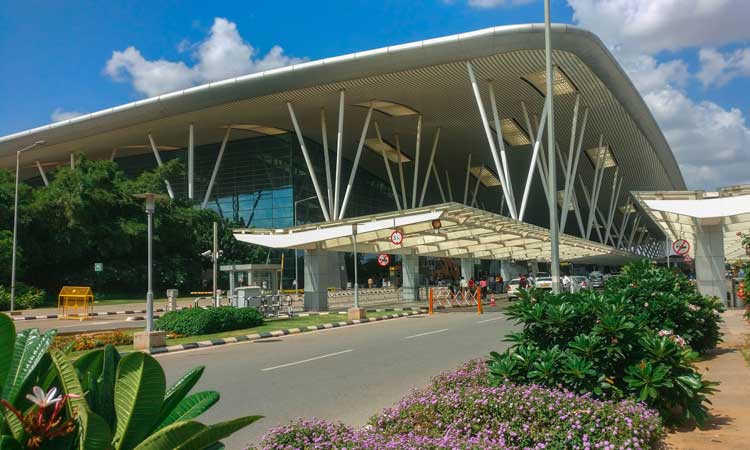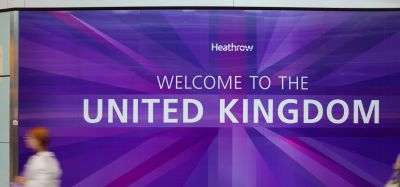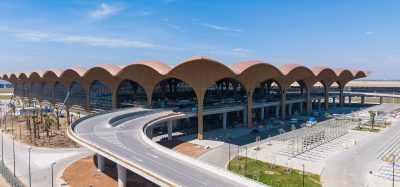Dealing with COVID-19 at Kempegowda International Airport
Posted: 29 June 2020 | Satyaki Raghunath | 2 comments
Satyaki Raghunath, Chief Strategy and Development Officer at Bangalore International Airport Limited, discusses how Kempegowda Airport responded to the unprecedented impact of the COVID-19 pandemic and how it is preparing for the full resumption of operations.


Kempegowda International Airport (BLR) in Bengaluru opened on 24 May 2008, and traffic steadily grew from nine million passengers per annum during the fiscal year of 2008-09 to 33 million passengers in 2018-19. This spectacular growth resulted in about 700 daily air traffic movements (ATMs) and 100,000 daily passengers before the onset of COVID-19.
To cater to this growth, BLR Airport was in the middle of its largest capital expansion programme ever, with a new independent parallel runway delivered in December 2019 and a second terminal that was, at the time, scheduled to be operational in March 2021.
Responding to the unexpected arrival of COVID-19
From the beginning, Bangalore International Airport Limited took proactive steps, along with our stakeholders, to deal with COVID-19″
As is widely known, COVID-19 has hit the wider travel and transportation industry disproportionately hard; with airports and airlines being impacted since early 2020. From the beginning, Bangalore International Airport Limited (BIAL) – the operator of BLR Airport – took proactive steps, along with our stakeholders, to deal with COVID-19.
The airport began to track arrivals from the most affected countries in January 2020 and invoked a Business Continuity Plan (BCP). In addition – based on government requirements – BIAL put in place various methods for health screening of passengers and crew from select countries around early-January 2020 in coordination with various stakeholders, including government health officials.
As the virus spread further, the Government of India (GoI) took the prudent decision of additional screening and quarantining of passengers arriving initially from select countries, and then all international arriving passengers by early March 2020. As different parts of the world started seeing a spike in cases, international commercial flight operations to and from India were suspended as of 23 March 2020, and domestic commercial flight operations were suspended as of 25 March 2020.
An effective airport-wide strategy
At BLR Airport, BIAL’s management team adopted four key strategies to deal with COVID-19:
- Single-point coordination – with a focus on an Incident Command System and a definite back-up plan for each critical function/ role
- Delegation of Authority (DoA) – with a focus on ensuring that BIAL could take appropriate measures (including financial), as quickly as possible to address emerging risks
- Quick decision making – enabling BIAL to deal with changing situations with a focus on on-ground execution on a war-footing
- Greater adaptability – ensuring BIAL had flexibility to develop new strategies based on evolving scenarios, as we learnt lessons from all over the world.
In order to execute the four strategies listed above more efficiently, BIAL activated the BLR Airport Public Health Emergency Plan, establishing one strategic group and three tactical groups:
- The Steering Group – a strategic leadership group, comprising of BIAL’s corporate executives (CXO) team, working with the Head of Enterprise Risk to drive decision making
- The War Group – comprising of the Head of Enterprise Risk with Heads of all Departments (HoDs) for rapid response, planning and implementation of various measures
- The Stakeholder Group – comprising key BIAL HoDs, along with airlines, concessionaires and sovereign functions (security, customs, health officials, etc.) to coordinate efforts
- The Regulatory Coordination Group – a group set up to focus on coordination with government officials (central and state governments) and, in doing so, ensuring 100 per cent compliance to all regulatory guidelines.
However, during this period, the team was able to focus on key areas of operational safety and security, health, hygiene and sanitisation in preparation for operational resumption”
During the 60-day lockdown period from 25 March 2020 through to 25 May 2020 when domestic operations resumed, BLR Airport only operated cargo operations and repatriation flights for both Indian and foreign citizens. However, during this period, the team was able to focus on key areas of operational safety and security, health, hygiene and sanitisation and process recalibration with a view to building consumer confidence in air travel in preparation for operational resumption.
From lockdown to stabilisation
BIAL’s response to the COVID-19 crisis can be divided into four distinct phases:
Lockdown Phase – 24 March to 1 May 2020
- Multi-level daily monitoring of local, regional, national and international scenarios
- Work from home for all employees, except the most essential services
- Employee health and well-being initiative and training
- Deep cleaning and sanitisation of the entire BLR Airport campus
- Increased focus on the use of technology and digital services for staff and other services.
Pre-opening Phase – 1 May to 24 May 2020
- Constitution of a Research Task Force to explore advanced solutions in preparation for reopening
- Execution of hygiene and physical distancing measures, including screening and the greater use of personal protective equipment (PPE) and sanitisation
- Realignment of people, budget and support systems, including critical supply chains
- Recasting of BLR Airport’s Capacity Declaration Plan to account for likely changes in passenger processes and distancing protocols.
Resumption Phase – 25 May to 7 June 2020
- Development and implementation of the Operations Resumption Standard Operating Procedure (SOP) and Response Protocols
- Monitoring and adjustment/ recalibration of SOPs and protocols
- Enforcement of distancing, sanitisation/ hygiene and personal protection measures.
Stabilisation Phase – 7 June 2020 and ongoing
- Regularising budget requirements and supply chains for continued COVID-19 response
- Alignment of business and operating plans to changing COVID-19 scenarios
- Confirmation and sign-off of stabilised strategy and processes and revoking the BIAL BCP.
The second and third phases were carried out with a major focus on building passenger confidence and developing processes for resumption of operations with an aim to ensure that the airport led from the front. They included:
- Close discussion, coordination and staggered slot allocation to ensure delivery of required levels-of-service, while adopting new processes and distancing protocols to ensure passenger and staff health and safety
- Improved screening protocols that involve thermal screening for all passengers (domestic and international), BIAL staff, CISF security personnel, airport taxi drivers and supervisors
- Distancing guidelines and measures across BLR Airport, including floor markings at processing zones, distancing measures at seating and waiting areas and glass partitions and enclosures at immigration, health screening and other processing zones, commercial outlets and information areas
- Increased disinfection, sanitisation and hygiene of all areas at the airport, including: passenger touchpoints (ATMs, trolleys, security screening trays, etc.); baggage areas and baggage; airside, terminal and landside equipment; fixed installations (railings, walls, handrails etc.); and taxi and waiting areas
- Focus on digital technology for the development/ refinement of ‘contactless or touchless’ passenger processing, ordering of food and other services
- Integration of the ‘Aarogya Setu App’ (an exclusive app developed and implemented nation-wide by GoI to track COVID-19 cases and ensure personal safety of its citizens through various mitigating measures) with airline PNR databases
- Enhanced health, hygiene and safety measures for individuals, including mandating the use of face masks and gloves, temperature screening of all staff and PPE for housekeeping staff involved in sanitisation.
Considering the benefits
The one benefit during this period has been the pace of digital transformation across BIAL”
While COVID-19 has impacted operation from a financial perspective, perversely, the one benefit during this period has been the pace of digital transformation across BIAL, including:
- Organisation-wide adoption of virtual meetings using Microsoft Teams
- The widespread use of our analytics platform – DICE – with over 100 BIAL staff being trained and serving as DICE Champions during this period
- The roll-out of the new BIAL website and the iOS and Android mobile apps during this phase
- Acceleration of the use of our process automation platform – e-Palm – for workflows and documentation.
Communication and well-being
BIAL has focused heavily on employee care and well-being and communication throughout the entire period”
BIAL has focused heavily on employee care and well-being and communication throughout the entire period, beginning February 2020. Employees have been regularly screened and monitored, offices and premises sanitised and PPE made available to all employees depending on risk exposure. In addition, a minimum of 30 per cent of BIAL employees continue to work from home to lower the risk of exposure/ transmission and maintain business continuity. Further, distancing norms have also been put in place at all premises and across all campus transport vehicles.
BIAL adopted a very proactive communication plan during this period. Beginning February 2020, regular advisories were sent to all employees via email and Microsoft streams. In addition, regular updates were also sent from the Managing Director and Chief Executive Officer to all employees and stakeholders to ensure transparency, visibility and empathy.
BIAL’s videos on the work completed by the operational teams during this time have had a huge impact in building passenger confidence. In addition, to make airport travel safe and healthy, ‘contactless processing’ from parking to boarding, in addition to contactless food and beverage (F&B) delivery to where passengers wanted within the terminal, was introduced. With greater emphasis on minimum touch and minimum exposure, the objective of contactless processing was to minimise all physical contact at the airport. The technology enabled us to offer a seamless airport journey, with greater emphasis on health and safety.
BIAL also embarked on a landmark social initiative, ‘Namma Chethana’, which focused on feeding the poor, underprivileged and needy.
Our video on contactless travel has had over six million views to date and has been widely praised. Between mid-April and mid-May 2020, BIAL also embarked on a landmark social initiative, ‘Namma Chethana’, which focused on feeding the poor, underprivileged and needy. During the lockdown period, the initiative prepared and delivered over 420,000 meals and 9,000 food and grocery packets across multiple districts in the region.
Revenues and financial support
It is known that airports have a higher proportion of fixed assets than airlines and, given that BLR Airport was in the midst of a major expansion (as outlined earlier), the timing of COVID-19 could not have been worse. Airport revenues can be split broadly into two buckets – aeronautical and non-aeronautical – with both of these revenue streams primarily driven by commercial passenger traffic. In the absence of scheduled operations, most of BIAL’s revenue streams dried up, causing significant financial stress, especially with an ongoing capital programme.
BIAL’s management team reached out to all aviation and non-aviation concessionaires and offered financial relief during the lockdown period”
However, despite these challenges and in an unprecedented move, BIAL’s management team reached out to all aviation and non-aviation concessionaires and offered financial relief during the lockdown period, based on our principle of collaboration and partnership.
In the first three weeks since operational resumption, BLR Airport has had a daily average of about 135 passenger ATMs and 13,000 passengers. While this is a fraction of our pre-COVID-19 traffic, it is still a start, and we believe that things will get better over the next few months. We continue to work with all our partners and stakeholders as we stabilise our operation and focus on the next phase of operational resumption – the start of international flights.
Biography
Satyaki Raghunath is the Chief Strategy and Development Officer at Bangalore International Airport Limited (BIAL). He came to BIAL with almost two decades of experience in working with public and private sector investors and operators of transport infrastructure, advising on business, finance, strategy, regulatory and project delivery related initiatives. He has extensive experience in transportation and airport system planning across major cities such as London, Chicago, Dubai, Houston and New Delhi.
Join our free webinar: Beyond silos: How ecosystem thinking elevates the airport experience
In today’s complex aviation landscape, airports are moving beyond siloed operations to embrace a new era of collaboration. This webinar focuses on how leading airports are using ecosystem thinking to adapt, personalize, and continuously improve every touchpoint, boosting both passenger satisfaction and non-aeronautical revenue.
Date: 13 Nov | Time: 10:00 GMT
REGISTER NOW TO SECURE YOUR SPOT
Can’t attend live? No worries – register to receive the recording post-event.
Related topics
Aeronautical revenue, Airport crisis management, Contactless / Touchless technology, COVID-19, Passenger experience and seamless travel, Passenger volumes, Safety, Terminal operations, Workforce



















Fantastic work done by BIAL! Kudos to the whole team.
Is there a covid testing facility at departures. Bangalore airport